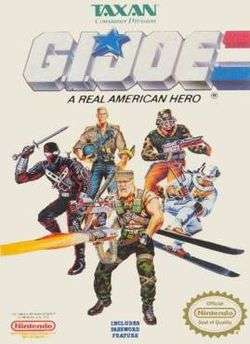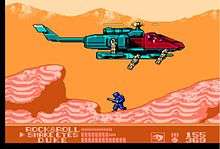G.I. Joe (NES video game)
| G.I. Joe: A Real American Hero | |
|---|---|
 Front cover | |
| Developer(s) | KID |
| Publisher(s) | Taxan |
| Designer(s) | Ken Lobb (producer) |
| Composer(s) |
Nobuyuki Shioda Yusuke Takahama |
| Series | G.I. Joe |
| Platform(s) | NES |
| Release date(s) |
|
| Genre(s) | Run and gun platform action game |
| Mode(s) | Single player |
G.I. Joe: A Real American Hero is a 1991 run and gun game published by Taxan for the Nintendo Entertainment System based on the toyline of the same name. The game was produced by Ken Lobb and developed by the same Japanese team that later formed KID. Another NES G.I. Joe game, G.I. Joe: The Atlantis Factor, was released the following year, but was published by Capcom instead of Taxan.
Gameplay

The player takes control of a team of three G.I. Joe characters, each with their own specialty. The player's goal is to navigate through six stages (with several areas each) on a mission to finally bring down Cobra. The initial character roster consists of Duke, Snake Eyes, Blizzard, Captain Grid-Iron, and Rock 'n Roll.[1] A sixth character, Hawk, gives orders to the team between missions, and becomes available as a playable character for the final stage.[1] Each level had a character that was pre-determined to lead the team, meaning that one character in the given area would be chosen by default, and the player would then select the two other operatives to complete their team.[2]
The player collects power-ups in the game that increases an individual character's abilities. Gun icons increases firepower, K-rations recovers energy, and Chevron icons increases the current character's maximum stamina. Bullet icons refills the player's collective ammunition and bulletproof vest icons that grant temporary invincibility are also available at designated locations on each area. Icons flashing in red are more valuable than ordinary icons. All upgrades garnered during the course of the game are permanent, provided of course the character survives the mission.
Certain areas have empty enemy vehicles that the main character can operate. The three different vehicles available are the Buzz Boar, the Pogo, and the Battle Copter. The player can still plant bombs while riding these vehicles.
The format of each stage is broken up into three different areas, which follows the following formula: In the first area, the player's team would fight their way into one of Cobra's bases. In the second area, the player's team has to plant a certain number of bombs inside the base before a pre-determined amount of time. The final area of the stage is a fight with the base's commander.[3] The game issues the player a password for each level completed.[4] The Cobra soldiers and bosses (Range-Viper, Metal-Head, Overlord, Voltar, Destro and Cobra Commander) are all based on characters from the toyline.
Plot summary
The six missions that the G.I. Joe team members must progress through each take place in a different part of the world: the Amazon, Antarctica, New York City, The Black Hills, and the Sahara.[1] The game's final mission takes place in Cobra Headquarters.[1]
Playable characters
There are five initial characters in the game (with a sixth character that becomes available for the final stage), each with his strength to bring to the game. The player can choose a team of three for each area. During gameplay, the player can switch between characters after pausing the game. The characters’ skills are agility, stamina, strength and firepower.[5]
- Duke – The most balanced, possessing the mid-level skills and powers of his comrades. He leads the team in Amazon mission.
- Snake Eyes – Can jump higher and punch/throw faster than his teammates. He is also the only one who does not use up any ammunition, using white fireballs instead (described in game as a sort of Jujitsu). While being able to conserve vital ammunition, Snake Eyes' weapon is weak. He leads the team in New York's sewer mission.
- Capt. Grid-Iron – Has the greatest fist power and is average in other departments. He is very similar to Duke, but with a shorter jump and a smaller spread weapon (described as grenade launcher). He leads the team in Black Hill Mission.
- Rock ‘n Roll – He has the strongest firepower (machine gun) and the widest range of all but all his other ratings below average. He leads the team in the desert mission.
- Blizzard - He is sub-par in most skills except stamina. Blizzard may come in handy during the Antarctic world, but otherwise does not stand out in any specific areas, though his (grenade) throwing speed is almost as fast as Snake Eyes. His special ability is that he can shoot through solid walls. He is in charge on the Antarctica missile base mission
- General Hawk – His appearance is based on the 1991 edition of his action figure. He is the only character who can fly and a requirement when facing Cobra Commander. He only becomes available for use in the final stage. In the course of the game, he was kidnapped by Destro and Rock 'n Roll led a team of operatives to rescue him from the desert.
References
- 1 2 3 4 Roberts, Matt. "G.I. Joe for the NES". YoJoe.com. Retrieved 2010-06-17.
- ↑ "game review". Mania.com. Retrieved 2012-09-17.
- ↑ G.I. Joe: A Real American Hero at MobyGames
- ↑ The Video Game Critic's NES Reviews F-L (includes G.I. Joe) at The Video Game Critic.
- ↑ Cedric Cooks/Oda (2002). "G.I. Joe: FAQ/Walkthrough". Retrieved August 5, 2008.
External links
- Game of The Week: G.I. Joe at GameSpy
- Nobuyuki Shioda ~ 塩田信之 (しおだ のぶゆき) at GameMusicComposerMEMO (Japanese)
| ||||||||||||||||||||||||||||||||||||||||||||||||||||||||||||